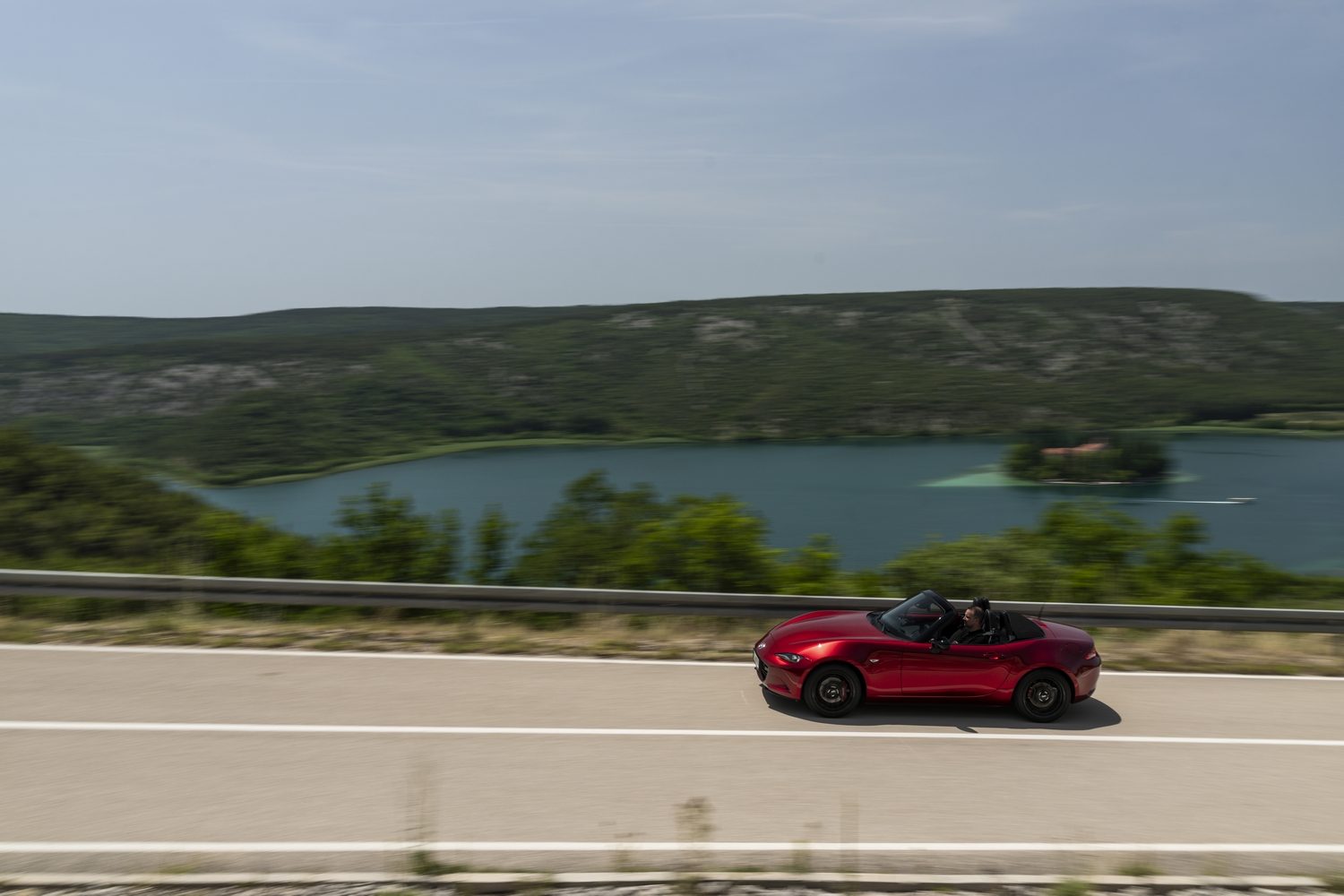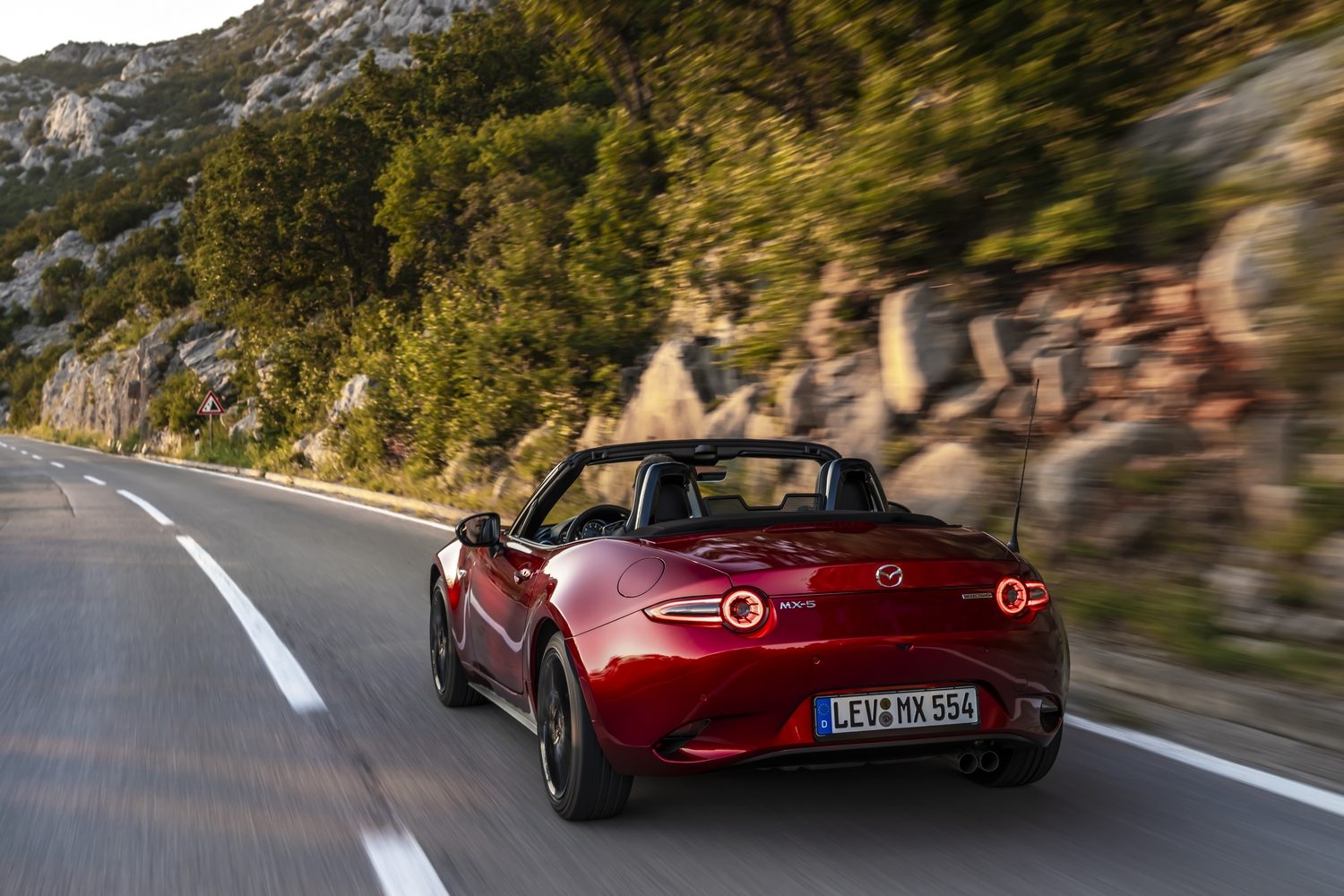By a happy coincidence, this week I’m driving a Mazda MX-5. I wasn’t supposed to be, but the test car booking schedule had a senior moment, and the only car available was a low, lithe, red MX-5. The version with the 2.0-litre engine, the extra strut brace between the front suspension towers, a limited slip differential and some gorgeous BBS alloy wheels. Oh, and Brembo brakes.

This year, the MX-5 - and this is the ND version, the fourth generation, on sale since 2015 - has been given a small round of updates to keep it fresh. The changes are tiny, extending to some infotainment updates and a new Track mode for the stability control system, cognisant that many MX-5 owners enjoy the occasional track-day event.
Other than that, the gorgeous little MX-5 remains as it has been for almost ten years now - simply one of the best cars to drive (defined by its perfect gearshift, perfect steering and sweet balance) and yet still a useable, fairly practical, largely affordable everyday car. Electric roof? Why bother when the convertible top can be unlatched and thrown behind your head in mere seconds.
The current MX-5 can’t live forever

However, the very fact that this generation of MX-5 is knocking on for its tenth birthday is in itself a worry. After all, small, affordable sports cars don’t seem to be extremely high on any car maker’s agenda right now. The only newly arrived rival for the MX-5 is the all-electric MG Cyberster, which is by contrast heavy, complicated and nearly twice as expensive.
Mazda had been tardy about confirming that it was working on a next-generation MX-5, but last year at the Tokyo motor show, there was a glimmer of hope. A low, sleek, hopelessly pretty coupe called the Iconic SP concept wasn’t a convertible but was clearly looking in the direction of a next-gen MX-5. While I love the look of the current model, the Iconic SP concept is even prettier, channelling some of the spirit of the best 1960s Bertone and Pininfarina concept cars. Even the bright ‘Viola Red’ paint job was overtly Italianate, hinting at inspiration from the golden age of affordable sports cars.
Then more recently came some very good news: Mazda’s going to make a next-gen MX-5 after all.
Well, the confirmation is not quite 100 per cent yet, but it seems as if development of a new car is moving apace. Masashi Nakayama, General Manager at Mazda’s Design Division, describes the Iconic SP as a career highlight, and is now hinting at the concept's deeper significance for Mazda beyond its mere attention-grabbing presence on a motor show stage. “This concept is not just one of those empty show cars. It’s been designed with real intent to turn it into a production model in the not-so-distant future,” said Nakayama.
A concept car full of intent
![]()
Designers often talk about the potential seriousness of intent when it comes to concepts and motor show cars. Perhaps, in some cases, it helps them justify the time and effort poured into a car which is, ultimately, destined to be a one-off show pony.
But then Nakayama’s words were backed up by his colleague, Naohito Saga, Executive Officer at Mazda's R&D Strategy Planning Division. Saga said: “Standing by the car, you should be able to picture what sort of engine would be housed under the bonnet. That’s how committed we were to crafting this concept car. The more time you spend looking at it, the more the car will reveal to you. In the development process, everything from position of the doors and tyres, to the length of the vehicle, the seating position of the occupants and visibility was meticulously researched before reaching the final specifications. It really shows how much we wanted to make it a car that manifests Mazda’s commitment for the future, especially in terms of sustainability and the future role of our rotary engine technology.”
Rotary? MX-5? Oh yes...
The whole point of the Iconic SP is that it takes the rotary-engined range extender concept seen in production already in the Mazda MX-30 REV crossover and expands upon it. The idea is that the Iconic SP uses a compact - and therefore light - battery for short drives, and then switches on a twin-chamber rotary engine, developing 370hp, for longer journeys.
Rotary engines are future-proof
![]()
How does having a combustion engine prep the MX-5 for the incoming electric future? Ah, there’s a bit more to it than that. You see, a rotary engine can run on petrol, but it can also run on a whole host of other fuels... “There are quite a few energy sources for carbon-neutral fuel,” says Saga on the breadth of fuel sources available. “There are different synthetic fuels, made using hydrogen and CO2 and biofuels, made from raw materials including plants, which are compatible with petrol and diesel engines respectively.”
In fact, it’s well known that rotary engines, with their intake and outlet ports separated by the entire width of the combustion chamber, rather than grouped together in the engine’s head as they are in a piston engine, are ideal for burning hydrogen as a fuel. Mazda actually developed some hydrogen-powered RX-8 coupes, in co-operation with Norwegian company Hynor, back in the early 2000s, proving the concept works.
With hydrogen power potentially coming back to the forefront as car buyers seemingly cool on their appreciation of electric cars, Saga says this rotary expertise could give Mazda a leg-up. “The rotary engine can be very compact and very powerful at the same time,” says Saga. “That’s one advantage, but also it can be powered by various types of fuels, and that could give us an edge in the race to find a feasible solution for the future of mobility.”
![]()
According to Saga, no matter which carbon-neutral fuel becomes mainstream, the rotary engine can adapt. This means that, by using fuels with low CO2 emissions in the refining process, the Mazda Iconic SP’s powertrain has the potential to reduce emissions by up to 90 per cent. Likewise, Mazda is also advancing a next-gen technology to capture CO2 from exhaust emissions. It's theorised that this could eventually become a way of combining hydrogen with captured CO2 to make synthetic fuel, turning Mazda into its own fuel supplier.
“Today, we are competing in the Super Taikyu endurance racing series in Japan to test the potential of carbon-neutral fuel, but in the future, we intend to experiment with technology to capture CO2 as well,” said Saga.
It’s not just about the MX-5
![]()
A new MX-5 isn’t the only big new model planned by Mazda. A new hybrid-powered CX-5 is coming in 2027, alongside a brand-new all-electric crossover, and the gorgeous EZ-6 battery-powered saloon, made in co-operation with China’s Changan Motors.
But it’s the MX-5 that tantalises the most. Ever since Mazda, almost single-handedly, revived the market for affordable two-seat sports car in 1989, with the original MX-5, the car has been a totem - not just for Mazda, but for car enthusiasts everywhere. The word that a new one is coming, complete with a rotary engine, is music to our ears.





